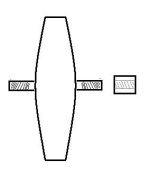hjns
100 kW
Well, I do not have the skills to replace the 12mm axle with a thicker one...Alan B said:My 9C axles are 10/14mm. The change to 10/12mm is apparently new. 12mm axles are much harder to keep from spinning. They are not as suitable for high power.
Good point. Actually, I choose the 2810 based on a 70% power delivery as compared to my rear HT3525 at the same voltage. However, I can certainly limit front amps even more. I still have the CA-LDP, and I can choose to which controller it is connected, so it is easy to limit the front controller "on the fly".Alan B said:I would consider limiting front axle power to a lower level, perhaps half or so of the rear power. So set rear at 45A and front at 25A. Especially for initial testing, perhaps even lower for early tests. Consider setting the phase current lower for less multiplication that causes high torque at low speed. Don't want the front wheel to slip.
Good idea. I already have asked DocBas about his TAs. I will probably end up epoxying these to the dropouts. At the same time, I will await the response from Rheinhard about his TAs.Alan B said:I would also consider stacking two of the torque arm sides to make the axle part thicker. The other piece, the torque strut, is not as stressed, so a single one there is fine.
OK, thanks. I had not thought of it that way, and it certainly makes sense. I guess I have to pedal up to a certain speed (or have the rear motor do the first 5mph) and then allow the front to kick in. Maybe I can program the controller to accept a throttle signal after a higher threshold. Alternatively, I can just add a resistor/variable pot to the throttle signal, to achieve the same.Alan B said:Consider this possible scenario:
Running 75V, 45A controller settings
Phase current limit set for 2.5x so 110 amp phase current max
Starting out the throttle is opened slightly. The motor has no back EMF since it is not rotating, so the voltage is very low and the current goes to 110 amps at a few volts, developing maximum torque. Power is only a few hundred watts, not kilowatts.
This is the condition that blows controllers and breaks torque arms and dropouts. Max torque, very little throttle.
Thanks for the new ideas! Certainly a lot to try out!



